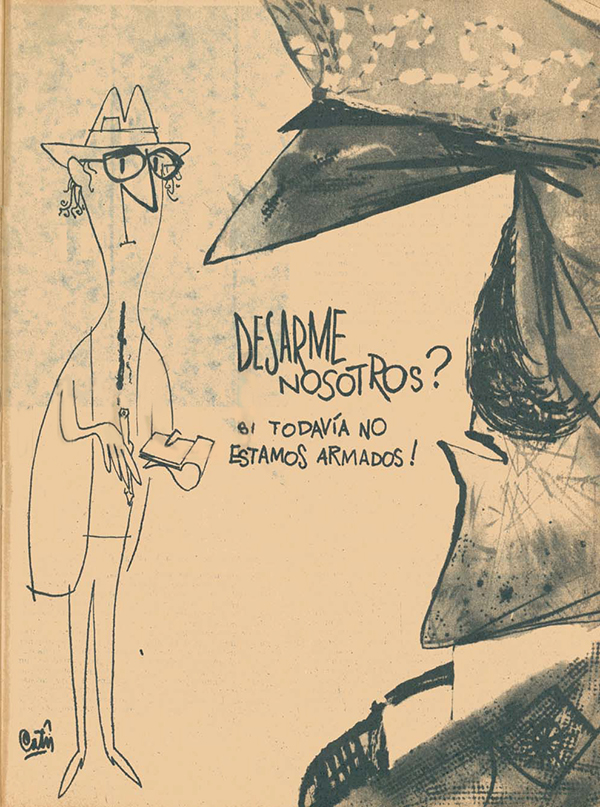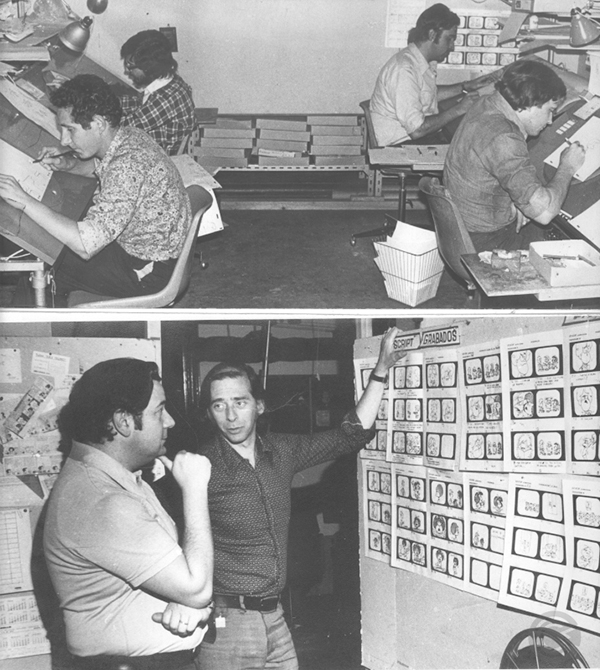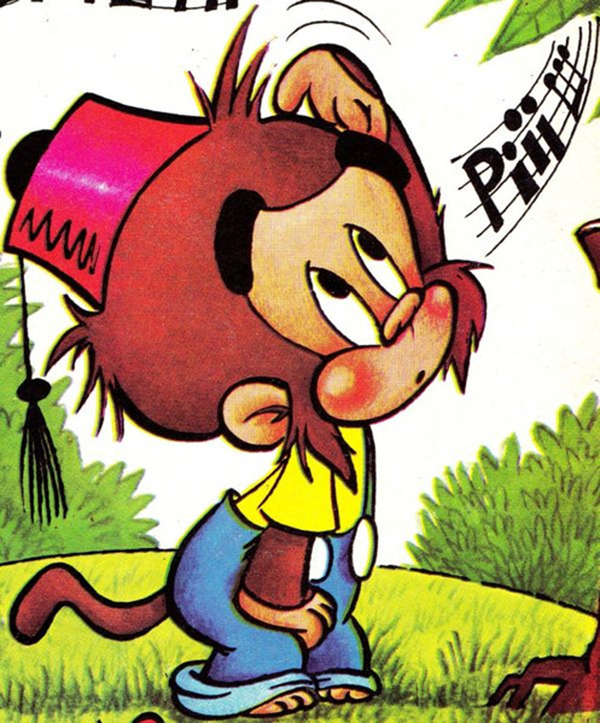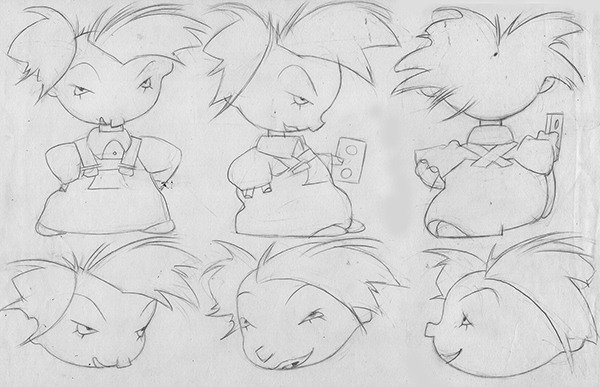
Although Catú (Jorge Martín, 1933-1997) began his work as an advertising animator in the 60’s, his signature would become representative of the best animated advertising produced in Argentina between the 70’s and 90’s, and many of his works were carved on fire in the brains of several generations. They are in mine, at least. However, very few are those who know the name of its author.
Like many advertising directors, Catú has a parallel career as a director of more personal creations, “festival shorts”, so to speak. The interesting thing is to see that in many cases these personal creations and Catú’s commercial work feed each other, to generate what a recognizable style that emerges below the adaptability to a client that advertising animation must necessarily have. Because Catú was a baroque, whenever possible; but a baroque aware of the power of synthesis. That is to say, an American baroque. I would like to have at hand the copies that his work deserves to demonstrate it, but unfortunately (and this will be a common problem) I only have low definition copies and You Tube, which would be like admiring the Sistine Chapel through a keyhole. Sorry about that.

Catú in Confirmado article
A note in Confirmado magazine in 1965 presented Catú as a renovating artist who paradoxically stood for a return to the simplicity of pioneers like Emile Cohl, filtered through UPA and Saul Steinberg: “Confirmado visited Jorge Martín (Catú) in his studio: an office room, divided by a partition. There he gathers his work tools: two drawing boards and the millimetric animation table, with its two vertical bars to move the camera.” Mention is made of his 1963 short film Compacto Cupé, a participant in the Annecy festival, his past as an art student, his collaboration with several “modernistic” humour magazines and his arrival in advertising production, “an activity where many creators of the new Argentine cinema have derived the impossibility of making films on the artistic level”. Aesthetically,” says Catú, “the cartoon, with its displays of trickery, its great laboratory of mechanical implements, invites us to detach ourselves from the flat surface of reality. And modern design, with its great power of synthesis, offers schemes freed from all naturalism, creates an essential reality. It should be noted that the cartoon in Argentina, like the short film in general, does not obtain any ease of access to commercial theaters”
Jorge Martin was born in 1933 in San Isidro (Buenos Aires), where he studied Arts and developed a recognized activity as a painter and engraver. The pseudonym Catú was born in 1958 to sign his humorous collaborations in publications such as Tía Vicenta, Cuatro Patas, Claudia and other Argentine and foreign magazines. The fact that Catú made comics in his beginnings may explain why he was one of the few directors capable of convincingly adapting the styles of other cartoonists (Quino, Carlos Nine, Fontanarrosa) to the screen.

Cartoon by Catu for Cuatro Patas
Since 1960 he devoted himself to advertising production. Along with his advertising production, Catú directed at least three short films as an author: La Pared (1962), Compacto Cupé (1963) and Buenos Días (1992).
One of his sons, Federico Martín (Matías, the other one, is a famous TV host), was a regular collaborator of Catú for many years and gives us a brief review of his career.
Federico Martin: I witnessed my father’s productions from the Mafalda strip produced for TV in 1972 (Mafalda is a famous comic strip by Quino – pseudonym of the humorist Joaquin Lavado – which had several adaptations to the screen). Afterwards he set up a production company, DiAnAr, which lasted until 1980 and then followed Catú Cineanimación with Rovira as partner and producer. Among the best known commercials are the series of Raid, Vivere, Bananita Dolca, Nesquik, Vienissima, 7up (animating Fido Dido’s character). And one shot commercials such as Banco Internacional, Pelikan, Volkswagen 1500, El Censo 1980, etc.
Links to principal ad shorts by Catú available on the web:
Eveready. Agency: Ortiz, Scopesi. Produced by DiAnAr and Oscar Desplats. Direction: Catú.
Tubby 3 and Tubby (1984)
Raid (1970) Note: the original “Raid bugs” were created by Tex Avery and then adapted to different audiences worldwide. In Argentina they danced the tango. Agency: J. Walter Thompson. Produced by DiAnar. Animation: Catú-Oscar Desplats. Voices: Pelusa Suero.
Raid (Tango, circa 1992).
Raid (circa 1981).
Banco Internacional (1979). Produced by DiAnAr and Oscar Desplats. Direction: Catú
Regarding the mechanics of production, he went to the meetings with Agency and Client where the commercial was proposed, usually with pencil and paper to plant something; then he returned a storyboard. In the 80’s he had permanent animators and/or assistants, but in the 90’s they were all freelancers. As you suspected, at first he animated more and then he mostly directed, choosing some shots to animate personally.
When there was a fixed staff I remember Luciano Marcatto in animation, Néstor Taylor or Nestor Pichel in backgrounds and Cristina Bertolami in tracing and painting. Among the freelance animators were Silvia Nanni, Natalio Zyrulnik or Alberto Grisolía, among the most usual ones, but there were many more: Perez Agüero, Carlos Baratto, Luis Cedrés… I’m sure I’m forgetting someone.
As for the artists he was in contact with, I remember the case of your father (Carlos Nine) for Tubby, a Round up commercial starring character Inodoro Pereyra put him in contact with Roberto Fontanarrosa, and with Caloi and his wife, Maria Veronica, he had a regular dialogue from the TV show Caloi en su tinta (Roberto Fontanarrosa and Caloi -Carlos Loiseau- were famous Argentine comic artists. The latter directed a TV show that for decades was the great showcase of animation in Argentina).

Silvia and Miguel Nanni during Mafalda production directed by Catú.
Interview with Silvia Nanni:
Silvia Nanni is an excellent Argentine animator (sister of the equally excellent Miguel Nanni), with whom I had the pleasure of working on the feature film “Anima Buenos Aires”. What follows is a brief report on her work, which involves Catú’s to a great extent:
-You started in the “Mafalda” project that Catú directed in the early 70’s…

Mafalda animation picts.
SN: – Yes, I was 19 when I started on Mafalda. Miguel was an animator on that production, and he invited me to learn with him. I loved the idea and I went to Catú’s studio (Azúcar Producciones) that was at Laboratorios Alex. The first few days Cristina Bertolami (an expert tracing artist) had me painting cels. Then Miguel explained to me how inbetweens were made, and I took off because I was already drawing since very young, like my sister, Ana María, and him. I was always a keen watcher of movements and gestures. So I started as an assistant, because in Mafalda we hadn’t Inbetweening as a position but Animation Assistant. Miguel had started working at 21 with Oscar Grillo.

Mafalda’s production team at work
My next job was at Recova, Editorial Atlántida’s production company, assisting in El Mono Relojero (1975-77). The animation director there was Carlos Costantini. Imagine what I learned with him!

El Mono Relojero
Then, with Berrino & Nanni (1979-81), I started to animate. While I was here I was called by Jaime Diaz, for whose production company I worked for 12 years (1982-94), doing animations for the USA and Europe (Hanna Barbera was the main client). Some animations were very limited and others were more elaborate. We were paid per foot of animation. It was a lot of fun working with a great team of people, and I met many cartoonists, among them Carlitos Meglia. In 1994 my son Tomás was born and I left the studio. But after a few months, Catú called me to animate advertising. So I drew as a freelance at home, next to the cradle.
Next I worked in the Dibu’s TV series and movies (“Dibu” was an animated character, designed and directed by Rodolfo Mutuverría, who interacted with live action. The goalkeeper of the Argentine national team took his nickname from him). We had a lot of work in those days! My time in animation has been really wonderful.
At some point in all this, Manuel García Ferré called me. He wanted to meet me and he wanted me to work at Manuelita. He was very attentive and paid very well. Then he continued with Pan Triste, and finally Soledad and Larguirucho. I generally animated female characters. I would tell you that whenever there was a female character it was mine.

Pandereta character for García Ferré, designed by Silvia Nanni.
-When you started to animate there were few women doing that…
When I started at Mafalda, I met a lot of people. Over the years, we all kept running into each other at the same places… In the back part of the studio, only women traced, painted cels, cleaned them, prepared colors, etc. In the front were the men drawing, painting backgrounds, doing production. It is true that as the years went by, I began to be told that I was one of the first women animators in the country who continued to work consistently until the present. I didn’t go to any animation school, I don’t think there wasn’t any then (I owe everything I learned to my brother, and to all the animators I met in all the studios). My old man was a cartoonist who had to work in something else, and my two brothers and I inherited his vocation.
-You had to move in a great variety of styles…
-It never bothered me. Just think that in every studio I went through, different work was done with different designs. I love to do both limited animation and full animation. At Jaime Díaz I animated Pac-Man, The Snorkels and The Smurfs, among others, but I prefer more elaborate animation. I tried digital for a while and I liked it but I didn’t continue. I only use TVPaint to animate, I think it’s good and it’s for drawing. Regarding the drawing style and its influence on animation, for me it is absolute. Maybe it’s something intuitive: Intuition is definitive to animate. I didn’t know about the twelve principles of animation, when I was animating with Jaime Diaz. Once, when I was animating Cap’n O. G. Readmore (for Rick Reinert Productions) he stood next to me asking if I animated intuitively or if I knew the principles… my answer was: intuition (with a little embarrassment) but… I had to read them when I decided to teach (another embarrassment).

O. G. Readmore
-Can you give us an overview of your career?
I learned from great animators, among them Miguel Nanni, Catú, Roberto García, Natalio Zirulnik, Nestor Córdoba, Carlos Perez Agüero, Luis Cedrés, Carlos Costantini, Jaime Díaz. No one spared their knowledge, on the contrary. Perhaps it seemed strange to them that a young girl was interested in learning the art of animation. Miguel used to tell me: try to feel the line. Catú: when we talk our hands are sometimes still. Roberto García: the in-betweens don’t always go in the middle. It sounds like common sense but it’s not! I learned during each production. I was in a great school. As time went by, when I was asked, I was encouraged to design female characters: Pandereta, Pantriste’s little friend. Manuel wanted me to have his style, and that’s how it was.
-What are your current projects?
-I give individual classes in my workshop, at home. Sometimes I give short workshops. There are several projects going around. Both painting and animation, and the cross between both disciplines. The title of the latter is Muybridge and I; 16 dancers in movement painted in oil on 16 loose canvases. I want to make a short film with it. These canvases were exhibited in two art galleries, what is still missing is the film! I am also working on a solo show, where I exhibit animation, painting and sculpture. I hope to be able to do it.
-I remember that you animated an advertisement for Tubby candybars that my father, Carlos Nine, had designed for Catú, in the ’90s. The animation is very good.
-Catú told me that Grisolía and I had a similar style, so he divided the advertising between us. One scene I animated, I acted it by combing my hair in front of the mirror. Catú said that the character looked just like me with those curls.
And that Tubby’s ad is a good colophon for this entry. It was directed by Catú for Casares Grey agency. The storyboard is by Catú. The character design and the final backgrounds were in charge of Carlos Nine. It can be seen, although not in great quality, at this link.
Recently I found, among old papers and dust, all the design work done by my father. This material offers the possibility to see the detailed pre-production that Catú’s short films had. But careful planning is what expected in a baroque, American or otherwise.

Above and Below: Tubby story, concept art and model sheets.
















 Lucas Nine is an Argentine artist: illustrator, graphic novel author, animator and director of animated films. His work has been awarded several times and published, exhibited and screened in Argentina, Brasil, Mexico, Canada, Spain, Italy, France, Germany, Hungary, Netherlands and Japan. Check out his animation and artwork online:
Lucas Nine is an Argentine artist: illustrator, graphic novel author, animator and director of animated films. His work has been awarded several times and published, exhibited and screened in Argentina, Brasil, Mexico, Canada, Spain, Italy, France, Germany, Hungary, Netherlands and Japan. Check out his animation and artwork online: 









































“Tubby: melts in your hip pocket, not in your hand….”
“Tubby” strikes me as an odd name for a candy bar. Everyone knows chocolate is fattening, but it seems rather poor taste to stress the point. I suppose that, to Spanish-speakers, “tubby” is just a cool-sounding foreign word, like “Ra-ID!” I love the commercials, and that groovy song.
If it weren’t for the credits and the Spanish dialogue, I would assume that “Compacto Cupe” had been made in Zagreb. Like “Buenos Dias”and the Garcia Ferre cartoons showcased here last week, it has a soundtrack made up of stock music and sound effects. I’ve noticed the lack of composed-to-order musical scores in these Argentine cartoons I’ve seen so far, and I’m sorry to say that it strikes me as a serious shortcoming in them. Perhaps a dedicated in-house composer was beyond the budget of these small studios. The commercials, at least, have some good original songs.
A very interesting point. Many Argentinian directors-animators have produced great videoclip animated shorts, obviously constructed over the soundtrack (Oscar Grillo comes to mind), but I don’t recall any important soundtrack produced as a whole for an animated production -except in advertising. But it may exist: it is very difficult to find archives of much of this production (as can be seen by the quality of some of these clips).
There’s something so striking about your father’s portfolio-size collection of detailed work for a single 30-second chocolate bar ad. You just don’t *see* that much of the time! Lovely article; I adore your passion and dedication to a country’s history of comics and animation in the face of fans’ tunnel-vision (unwilling or otherwise).
Thanks! It started with a Moviola…
I am loving this series Mr. Nine. Argentina has such a wonderful tradition of cartoon and graphic arts. It’s a real pleasure to learn about it from one of the countries great practitioners.
Here is another sample of INFORMATIVO INFANTIL BILLIKEN. The male announcer in off is Horacio Galloso.
https://www.youtube.com/watch?v=rBmYyswg8rY
And here is a sample of another Pelusa Suero commercial (all the voices in here).
https://www.youtube.com/watch?v=d89JkFiW8jc
Besides “The Smurfs”, “The Snorks”, and the second season of the 80’s Jetsons series, I’ve seen Jaime Diaz’s name come up in the end credits of some of H-B’s short-run cartoon series’ of the 80’s such as “Foofur”, “Paw-Paw Bears”, “Galtar And The Sacred Lance” and “The Completely Mental Misadventures Of Ed Grimley”. I believe Diaz’s studio was also involved with H-B’s most ambitious co-production they’ve ever done for the home video market, the “Great Stories From The Bible” series. Is that correct?
I’m not sure of the complete output of Jaime Diaz productions but Hanna Barbera was probably his main client through the years. Diaz would be another interesting choice for one of this articles. I know many of the artists that worked with him, as Silvia, and they are invariably good to great. I have also in some place the “stylistic guidebook” that Hanna Barbera provided his overseas artists (like Jaime). Interesting piece of reading.